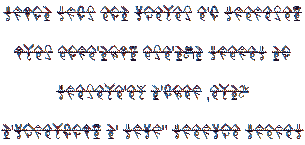Koromira love poem
Te Karasi
Dakanang U'a karasi eta Kung etong
Te Ganang eve'aka dome'anta Karo
Bera, Namu'e Pa'arakang
Ganang asinang " Ning 'e doturansi'e
With the Otomaung script (Dr Piers Kelly)
Font credits: Steven Tamiung, Peter Karatapi, Julia Bespamyatnikh, Siva Kalyan.

In Latin letters
Te Karasi
Dakanang U'a karasi eta Kung etong
Te Ganang eve'aka dome'anta Karo
Bera, Namu'e Pa'arakang
Ganang asinang "Ning 'e doturansi'e

→ French poem ←
Koromira
A new version of my little love poem, here in Koromira, a language of Papua New Guinea. For this translation i have used police Naasioi Otomaung script ... you could find more information about this alphabet on the other nasioi translation of my poem.
Koromira (Koianu), is a Papuan language, and more precisely, a nasioi language of the southern Bougainville group, spoken in the district of Kieta, in the south-east of the island of Bougainville.
The Koromiras who speak this language, live in the mountains of the center and south-east, more precisely between the Luluai and Metong rivers ... There are no more than 3,500 speakers for this language, even including those of the koianu dialect.
Some consider that Koromira, Lantanai, Oune and Simeku are dialects of the nasioi, the whole nasioi has 10,000 speakers.
In the province of Bougainville: nine Papuan languages are spoken there, generally in mountainous regions, and inland; and sixteen Austronesian languages, usually in coastal areas.
In total, counting the dialects, there are perhaps about fifty idioms, spoken by different groups in the province.
Austronesian languages are languages that came from southern China 6,000 years ago by migrants, who first passed through: Taiwan, the Philippines, Indonesia, Madagascar, Singapore, Malaysia and parts of Mainland Southeast Asia. Then they moved to the island of New Guinea about 4000 years ago ... they will settle near Bougainville about 3000 years ago.
The island of Bougainville, shows traces of occupations, which go back to 30,000 years ... The Papuans are the descendants of the natives who occupied New Guinea at that time.
The Papuan languages are their languages, Koromira is one of them; and all these languages, did not fail to meet in New Guinea the Austronesian languages of the new arrivals.
From a linguistic point of view, one realizes how numerous were these contacts, and the interactions between two groups so different. On Bougainville, this symbiotic relationship between Papuan and Austronesian languages is typical, and all these interactions, over such a long time, are one of the elements at the origin of the important linguistic diversity of the province.
Currently, there is nothing to indicate if the present-day Papuan speakers of Bougainville descend directly from an original Papuan colony.
Bougainville
Bougainville, is both the name of a province, and of one of the Solomon Islands forming part of Papua New Guinea.
The province of Bougainville, which is part of Papua New Guinea, comprises a string of islands (including the island of the same name), located to the east of mainland Papua New Guinea.
It is the French navigator Bougainville who in 1768 explores this island which will take its name.
It is Germany which will subsequently be present on these islands of Papua New Guinea. Then, after an Australian tutelage, the independence of the island will be proclaimed in 1975, and it will be attached to Papua New Guinea.
Naasioi